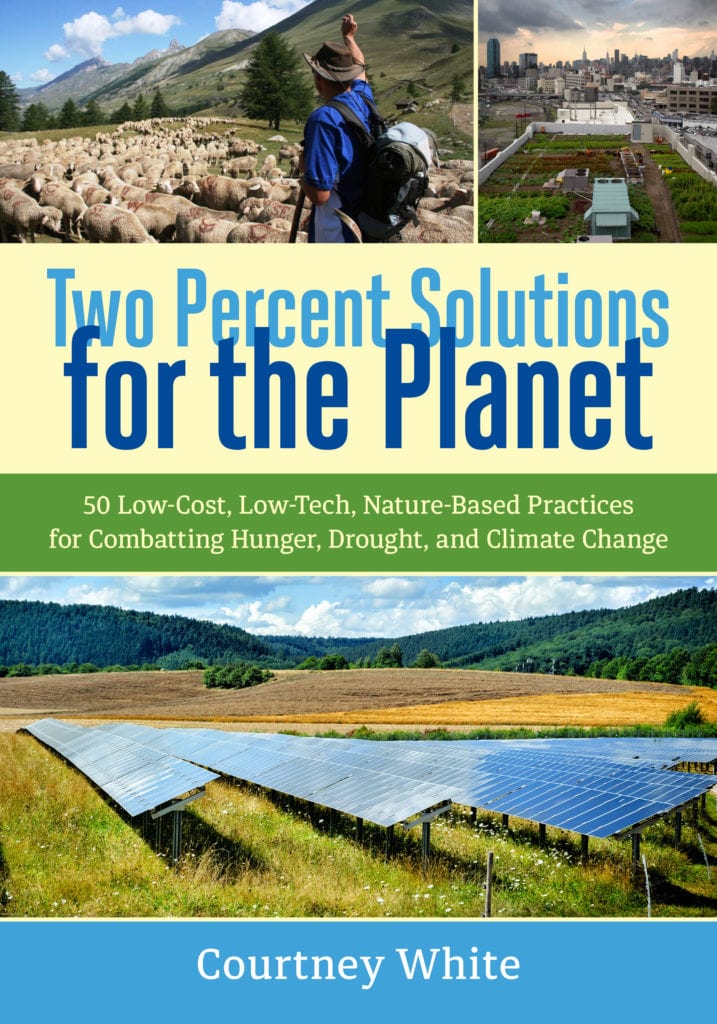Two Percent Solutions for the Planet: 50 Low-Cost, Low-Tech, Nature-Based Practices for Combatting Hunger, Drought, and Climate Change
 Written by Courtney White
Written by Courtney White
Published by Chelsea Green Publishing, 2015
Reviewed by Theresa Sprague
In his introduction to Two Percent Solutions for the Planet, Courtney White explains that the two percent in the title refers to:
- The small amount of additional carbon in the soil needed to reap a wide variety of ecological and economic benefits.
- The portion of the nation’s population who are farmers, ranchers, and others who can get this work done; and
- The low financial cost of these solutions – only 2 percent of the nation’s gross domestic product.
White points out that two-percent is an “illustrative number,” and not a “scientific one,” that is meant to “stimulate our imaginations,” and indeed this easy to read book does just that. The hopeful tone of the book is established in White’s introductory chapter titled “Solutions Abound” and continues throughout the book as he explores these solutions through mini-case studies of work being accomplished by inspirational people around the world.
The book is broken down into five sections: Ranching, Farming, Technology, Restoration, and Wilderness, though as one reads through each section it quickly becomes clear these delineations are not as distinct as the book’s organization might first make it appear. Just as solid whole-systems’ design and practices should overlap, discussion in each of the five areas also overlap and stories abound!
Each of the five sections contains ten individual examples of real-life, sustainable and regenerative practices in three- to four-page bite-sized chunks. White provides information for further reading or study at the end of each story. This chunking of information makes the book accessible for even the most time-crunched reader. And, there is no need for orderly first to last chapter study. Readers can open to any story and be inspired, whether they have 5 or 10 minutes while waiting for an appointment, or longer stretches to read several stories at a time.
For long-time practitioners of regenerative land management and design, most of the examples White provides will be familiar, though inspirational none-the-less. However, for those people who are just starting to explore issues of sustainability, carbon sequestration, climate change, clean water, food security, restoration, and reclamation, this book will indeed stimulate the imagination and encourage readers to explore further.
About the Reviewer
Theresa Sprague is the owner of BlueFlax Design in Mattapoisett, MA, where she focuses on merging science with the fine art of landscape design to create beautiful, ecologically sound, and sustainable landscapes, restoring ecological function and integrity to the built environment. She seeks to create habitats that support the needs of both people and wildlife. Theresa holds a master’s degree from the Conway School of Landscape Design and has over 15 years of planning, design, ecological restoration, gardening, and land management experience. She may be reached at theresa @ blueflaxdesign.com.
***
Each author appearing herein retains original copyright. Right to reproduce or disseminate all material herein, including to Columbia University Library’s CAUSEWAY Project, is otherwise reserved by ELA. Please contact ELA for permission to reprint.
Mention of products is not intended to constitute endorsement. Opinions expressed in this newsletter article do not necessarily represent those of ELA’s directors, staff, or members.

